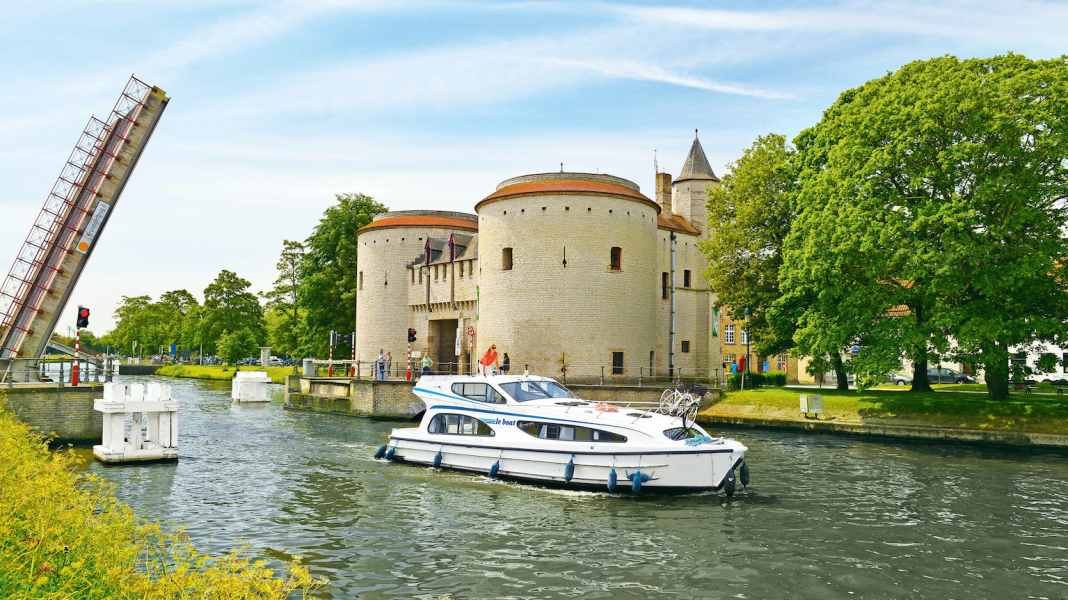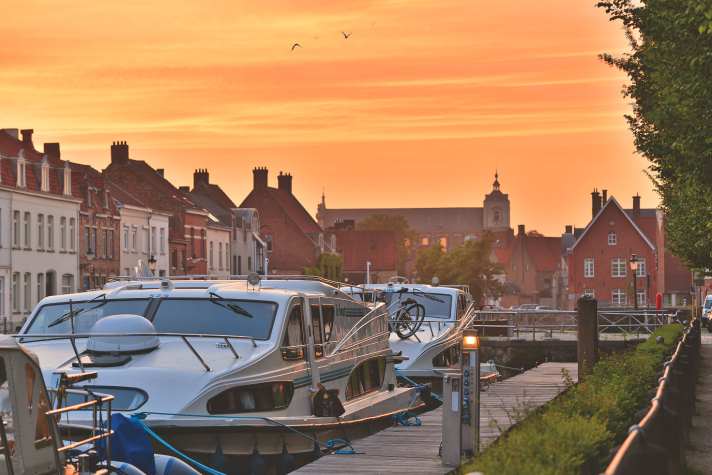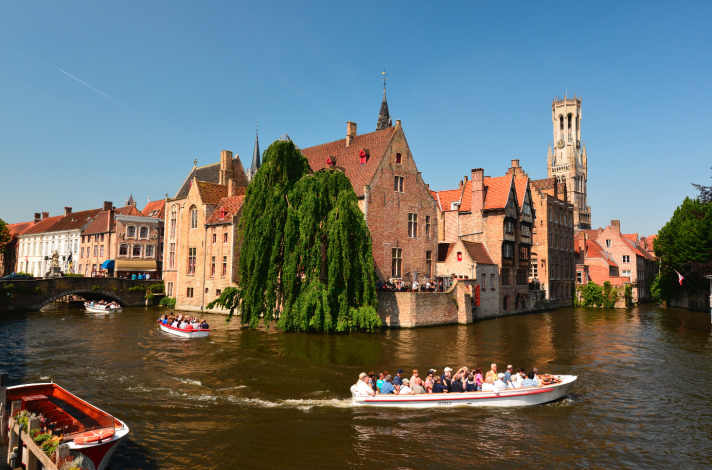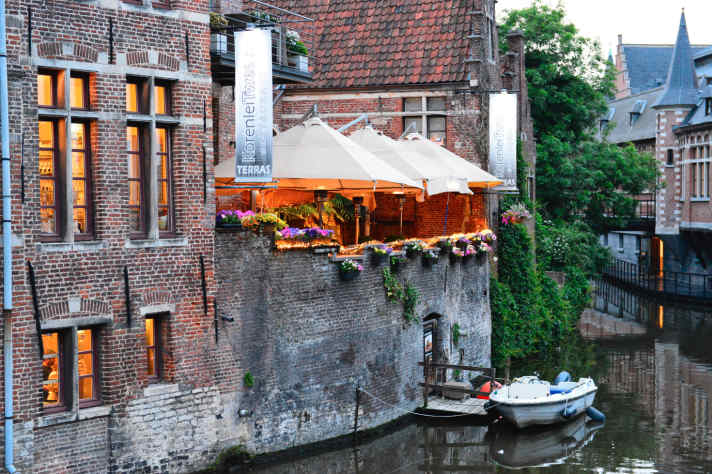
You can't sleep in. Convoy sailing is the order of the day on the first charter day. We leave the Westhoek Marina in Nieuwpoort at 8.30 a.m. and head for theCaprice from Le Boat Le Boat eastwards into the Plassendale-Nieuwpoort canal.
The sun peels out of a veil of haze and sea mist. You can almost smell the North Sea, whose coastline runs parallel to the canal one and a half nautical miles to the north. This connects the harbour town of Nieuwpoort, where the charter base is located, with Plassendale to the east, from where the Ghent-Oostende canal leads on to Bruges.
The first canal has seven bridges and a lock that have to be operated, followed by a further nine drawbridges on the second canal section to the centre of Bruges.
In order to facilitate shipping traffic and the opening of the manyDrawbridges, swing bridges, lifting bridges and swing bridges In order to coordinate the route between Nieuwpoort and Plassendale, there will be convoys travelling from Nieuwpoort in the direction of Bruges from 9 am and on the following odd hours until 5 pm. In the opposite direction from Plassendale, the convoys will run from 10 a.m. and then on all even full hours until 6 p.m.

The convoy should gather in front of the first bascule bridge, the Rattevallebrug. According to the regulations, the first ship leads the convoy and is responsible for theRadio communication with bridges and locks responsible. This takes place via VHF channel 20, then shortly before Bruges on channel 18. All shipping traffic is monitored and coordinated by a control centre.
We arrive at the Rattevallebrug ten minutes before 9am. Fortunately, another boat, a Linssen flying the Belgian flag, is there. That's the whole convoy. Because we don't know our way around here, we're happy to letthe local crew so that she can lead the convoy. We switch the radio to channel 20 to follow the conversations with the traffic control centre.
Five minutes before nine, the skipper radios the traffic control centre. They speak Flemish, a Belgian dialect of the Dutch language.
With a little effort, we understand the content. The control centre says that they see us on the video and asks if there is another boat behind us. As no one comes any further, theTraffic light on greenand the Rattevallebrug opens as if by magic.
The next six bridges are similar. After 20 kilometres and a good two hours of driving, we reach the Plassendalesluis, where we are lowered a few centimetres to the level of the kanaal Gent-Oostende. From now onshipping traffic increases significantlyThese are mainly cargo ships travelling from the North Sea port of Ostend towards Bruges. English is now also spoken on the radio. After another 15 kilometres along the canal, we see the towers of theOld town of Bruges shine.
The canal runs north and east around the historic city centre. A park with centuries-old windmills known as the Sint-Janshuismolen, one of the sights of Bruges, comes up on the starboard side.
The drawbridges that we now pass are already part of the medieval defence system of the once rich trading metropolis. On the starboard side, where the old town lies, traffic passing the bridges has to thread its way through narrow gates in mighty defence towers. Time and again, there are interruptions when ships request that the bridges be opened.
We pass the historic Kruispoortbrug and announce to the traffic control centre on VHF that we don't want to continue our journey, but want to enter the city harbour of Coupure. I'm just about to radio the harbour master on channel 18 so that he can raise the suspension bridge over the harbour entrance when I see him coming on his bike. He waves to me and opens the bridge.

He has obviously been listening in on the radio communication with the traffic control centre. The friendly man gives us a berth in the very centre of the Coupure harbour, right next to the old town. His wife is already waiting there to take the lines from our boat. The harbour master follows on his bike, hands us the Wi-Fi password, a map of the city and brochures about sights and restaurants.
The harbour master's wife says we have the most beautiful berth, right next to Jacques Brel's "Marieke". The life-size bronze statue by Jef Claerhout next to our jetty shows a pretty young girl with a revealing cleavage, flowing hair and a mini dress.
It is the Marieke of whom the famous chansonnier Jacques Brel once sang: "Oh Marieke, Marieke, I loved you so much between the towers of Bruges and Ghent." It was Brel's patriotic love song to his native Flanders.
Bruges, which was never destroyed in the war or rebuilt in modern times, still retains its medieval beauty today. Back then, Bruges was one of the richest cities in Europe with its navigable connection to the North Sea. Cloth production and trade were the basis of its prosperity. The city centre, surrounded by canals, ramparts, drawbridges and fortified towers, is a UNESCO World Heritage Site.

It's just a few steps from the harbour to the old town. We are overwhelmed by the beauty: Grote Markt, Provinciaal Hof, Basilica of the Holy Blood, City Hall and Rozenhoedkai - nowhere else are there so many magnificent medieval buildings in such a small space. On the Grote Markt, flying traders bake the typical Belgian waffles and top them with cream and fruit. In the picturesque alleyways around the market, chocolatiers present their finest chocolates.
In the evening, we recommend heading to one of the many breweries. Belgium has a long tradition of brewing exotic fruit-flavoured beers that cannot be found anywhere else. It is said that 500 different types of fruit beer are known and drunk in Belgium.
Bruges offers so many sights that you would have to stay for several days. Our problem is that we have only chartered the boat for a week. We therefore have to turn our backs on the Flemish beauty after just one night if we also want to see Ghent as planned.
The next day at 2.30 p.m. we leave the Coupure harbour in Bruges and turn to starboard into the Ghent-Oostende canal. Our destination is the metropolis of Ghent, 55 kilometres away. We report to the traffic control centre via VHF channel 18 and ask for the Gentpoortbrug to be opened, but are told that we have to wait.
A large cargo ship is coming from the north and we have to make way for it. We are only allowed to pass the bascule bridge behind the freighter. As this is an important access road to the city centre, it cannot be opened because of a single boat.
After half an hour, a barge so large that we can hardly imagine it fitting through the relatively narrow bascule bridge comes creeping up from the north. It is now fully open and everyone is staring at the freighter.
To be on the safe side, we crawl all the way to the side. But the ship threads its way in so precisely that there is still a hand's breadth of air on each side. We follow in its wake.
We only encounter a few pleasure craft on the Ghent-Oostende canal. The only pleasure craft harbour is on the south bank of the canal, in Beernem. We pass the drawbridges and the only lock there in convoy with cargo ships. Otherwise, there is little to see on this relatively long stretch of canal and no opportunity to moor. After three and a half hours of travelling, the Afleidingskanaal van de Leie crosses the waterway to Ghent. From this point onwards, things become much livelier.

After another eight kilometres, we reach the Ringvaart Gent, a shipping highway that forms a semi-circle around the west of Ghent. It demands the utmost concentration, even from experienced skippers, because it's a busy place: Container ships, tankers, timber freighters and pushed convoys carrying scrap, gravel, coal and ore travel in both directions. The radio is never silent for a second. People are constantly talking in Flemish, French and English.
Initially, we try to keep up with the flow of traffic, but soon realise that we are too slow and have to constantly swerve out of the way. In these situations, I also have the feeling that our charter boat is underpowered.
There is not only a lot of traffic on the water, but also on land, and it is annoyingly loud. The canal is flanked by a multi-lane motorway - the waterway forms the green strip in the middle, so to speak. After seven kilometres, we can escape the traffic on the water and on land. We turn left from the Ringvaart Gent towards the city centre. Now we are sailing relaxed on the River Leie, which takes us through quiet suburbs right into the centre of Ghent.
In the evening, we reach the Gent Ketelvest harbour, where a dozen boats are moored on the west bank. The friendly harbour master shows us a berth, takes the lines and hands us the password for the internet. Just then, the heavens open and a torrential downpour pours down on us. We cancel the walk to the nearby old town of Ghent and get the spaghetti out of the oven.
In the morning, the blue sky lures us out of our bunk. The historic city centre is just 600 metres away. With a quarter of a million inhabitants, Ghent is about twice the size of Bruges and is not inferior to its little sister in terms of architectural splendour. Ghent also once became wealthy and powerful thanks to the cloth trade.
Once again, we have the feeling that one day is very short to get an impression of the city. With more than 9800 culturally and historically valuable listed buildings, Ghent competes with Bruges, which is more popular with tourists.
The city skyline has been dominated by "de drie torens", the three towers, since the Middle Ages. These are the Ghent Belfry, the tower of St Bavo's Cathedral and the tower of the Sint-Niklaaskerk on the Kornmarkt. The former guild houses along the canal of the old harbour, the Graslei and the
harbour, the Graslei and the Korenlei.
Belgian specialities such as truffles (handmade chocolates in every flavour) or cuberdons (jelly-like sweets in the shape of a nose) are offered on every corner. And in the many open-air restaurants, you can quench your thirst with the typical Belgian Kriek, a cherry-flavoured beer.
After a day full of impressions, we unfortunately have to untie the mooring lines. To take in a few more impressions of this wonderful city, we take a short diversions through the canals of the old town and then head south on the Muinkschelde towards the Ringvaart water and road motorway mentioned earlier.
The Sluis E3 in front of it should actually always be open - but today it is closed. We call and find out that it had to be closed because of the rain. Twenty minutes later, it is opened for us and another pleasure craft. We head back onto the busy shipping lane. After five kilometres, we turn west into the River Leie.
Peace at last. While the roar of the motorway remains astern, an unexpected paradise opens up before us. A narrow, meandering river with reeds and water lilies, swans, ducks and herons everywhere. Even after we have left three bends in the river behind us, it remains calm and beautiful - but in a completely different way:
Villas, castles, palaces, one more beautiful than the other, line both banks. All private, mooring prohibited. You get the impression that the richest Belgians have spent their millions on this stretch of the Leie. Twelve
kilometres of river to look at and marvel at.
After an hour and a half, the landscape becomes unspoilt again. Meadows and pastures line the river. The evening sun sets fire to the reed forests. At kilometre 66, we discover the "Halifax" inn on the south bank with its own jetty. It consists of a terraced garden above the Leie. All the tables are occupied. The guests are strikingly elegantly dressed - perhaps the residents of the villas and palaces? They celebrate their dinner in the beautiful sunset.

"Do you have a reservation?" asks the usher. No, we haven't - so we have to watch the natural spectacle from the waiting lounge with table wine and savoury sticks. When the sun has gone and the first table becomes free, we are allowed to move up. We enjoy an excellent game dish, knowing full well that it's not cheap here. But we have a free berth. Charter guests are better off booking a table. www.gasthofhalifax.be
In the morning, we continue westwards on the Leie, pass the Astene lock and bridge after two kilometres and reach the small town of Deinze, which is dominated by a tall church, four kilometres further on. The Tolpoortbrug is opened just for us and shortly afterwards we turn right into a large shipping lane, the Afleidingskanaal van de Leie, which leads to the North Sea port of Zeebrugge.
There is a lot of traffic here too, but fortunately this canal is not also the central reservation of a motorway, so you can drive in peace. A good hour later, we turn left at the next major junction into the Ghent-Oostende canal and start our journey home towards Nieuwpoort.
As it is no longer possible to make the journey in one day, we are delighted to be able to spend the night in the beautiful centre of Bruges for a second time. As we turn our bow towards the sunset, we feel a little nostalgic - because we could never have imagined how interesting it would be to discover Belgium from the water.

